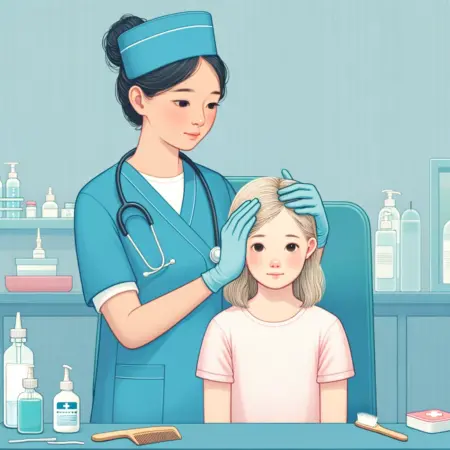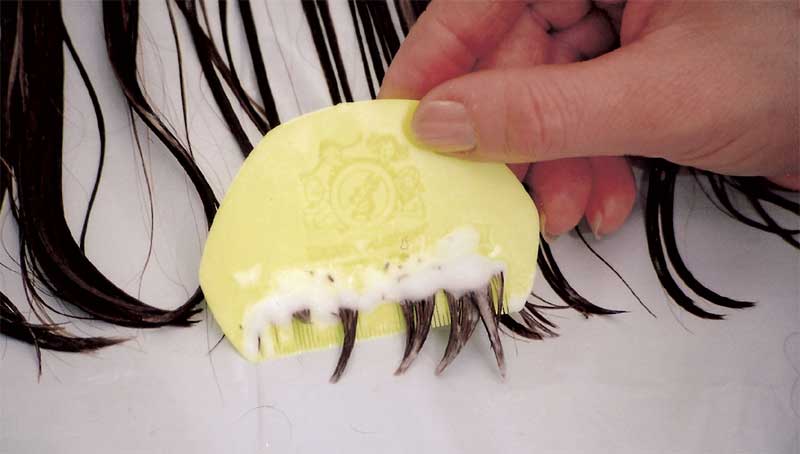Pediculosis Treatment Nursing Procedure is the process of removing head lice parasites.Pediculi or head lice are small parasites which are blood sucker and live for several days or weeks in hair. Usually they find comfortable stay in long hairs especially in women. But they can also be seen in male hair. They are grey in colour and move by tiny! from one place to other on scalp. The female lays about 40-50 eggs. These are called nits and appear grey or white specks sticking to hair. They hatch in about 7-10 days.

Symptoms of Lice Infestation
- Itching of scalp and neck area.’
- Rash type eruptions over scalp and behind ears.
- Sores over scalp.
- Restlessness and irritability.
- Incidental appearance of living louse on dress near neck m Drugs used for pediculosis capitis.
- DDT; (Dichloro Diphenyl Trichloro Ethane) powder part to nine parts of talcum powder. This destroys \ lice in about two hoars when applied over scalp. B* does not destroy nit or eggs. If the hair is not wai then the effect lasts for about six days. DDT emulsion also available in liquid form.
Kerosine oil mixed with equal part of sweet oil: This mixture of oils destroys both adult lice and eggs or nits. But from aesthetic point of view, kerosine causes foul smell I thereby discomfort to patient and attendant.
Oil of Sassafras : This is a kind of scented bark oil. It only destroys lice not nits, for complete irradiation, the oil should be massaged again after ten days when the nits hatch. This oil is used daily for a week with equal parts of lukewarm water. Then it should be repeated after a week.
Gammaxene (Gamma Benzene Hexachloride) : 1 to 5% solution of Gammexane is also effective to kill adult lice in one application. But this also does not kill nits. So the application of this solution should be repeated after 8-10 days to kill the newly hatched nits, for complete eradication. This solution is available nowadays in various trade names like ‘Scabiped lotion’, ‘Scarab lotion’, ‘Emscab lotion’, etc. The lotion is applied over scalp after a clean soapy wash of hair. After 12-24 hours the scalp is washed with soap to remove the lotion. Care should be taken to avoid contact to eyes.
Nursing Material
- Mackintosh 2. Tray 3. Bowl of swabs 4. Bowl with ~ie 5. Bowl with medicine 6. Kidney tray 7. Comb 8. Bowl collection of waste materials 9. A cap to cover patients hair treatment.
Pediculosis Treatment Nursing Procedure And Lice Treatment Procedure
- The nurse cleans her hands and puts on gown.
- A bed side screen is put for privacy.
- The patient is intimated about the procedure.
- Apply vaseline to the skin at hair-line to prevent skin irritation.
- Apply medicine to hair and scalp according to type of medicine as indicated for each medicine.
- The hair is fastened in a cap for the night.
- Carefully remove the macintosh and make the patient comfortable.
- The gown of the nurse should be disinfected in a bucket of water with antiseptic solution.
- Wash hands thoroughly.
- The hair is washed with soap after 12-24 hours as indicated for the type of medicine used.
- Repeat the procedure after 10 days to kill newly hatched nits.
- Any allergic reaction to drug applied over scalp should be promptly treated.
The treatment of pediculosis, commonly known as lice infestation, in a nursing context can be outlined in a tabular format as follows:
| Step | Procedure | Notes |
|---|---|---|
| 1 | Assess the Patient | Check for signs of lice (nits, live lice) on the scalp, behind the ears, and neck area. |
| 2 | Educate the Patient and Family | Explain the nature of the infestation, transmission methods, and treatment process. |
| 3 | Choose the Appropriate Treatment | Select a pediculicide (lice treatment shampoo or cream). Consider any allergies or sensitivities. |
| 4 | Application of Treatment | Apply the treatment according to the manufacturer’s instructions. Ensure full scalp coverage. |
| 5 | Comb Out the Nits and Lice | Use a fine-toothed lice comb to remove dead lice and nits from the hair. |
| 6 | Clean Personal Items and Bedding | Wash bedding, clothing, and personal items in hot water or seal in bags for two weeks. |
| 7 | Repeat Treatment if Necessary | Some treatments require a second application after 7-10 days to kill any newly hatched lice. |
| 8 | Follow-up and Reassessment | Check the scalp after treatment completion to ensure all lice and nits are gone. |
| 9 | Prevention Education | Discuss ways to prevent re-infestation, such as avoiding sharing personal items. |
| 10 | Documentation and Reporting | Record the treatment provided and report any cases to relevant school or public health authorities. |
This table provides a comprehensive overview of the steps involved in treating pediculosis in a nursing setting, emphasizing both treatment and preventive measures.
Conclusion
Pediculosis treatment requires a comprehensive nursing procedure to ensure successful eradication of lice and eggs. Nurses play a vital role in assessing, educating, and assisting patients throughout the treatment process. By following the step-by-step approach outlined above, nurses can promote effective pediculosis treatment, minimize the risk of reindentation, and improve the overall well-being of the patients they care for
